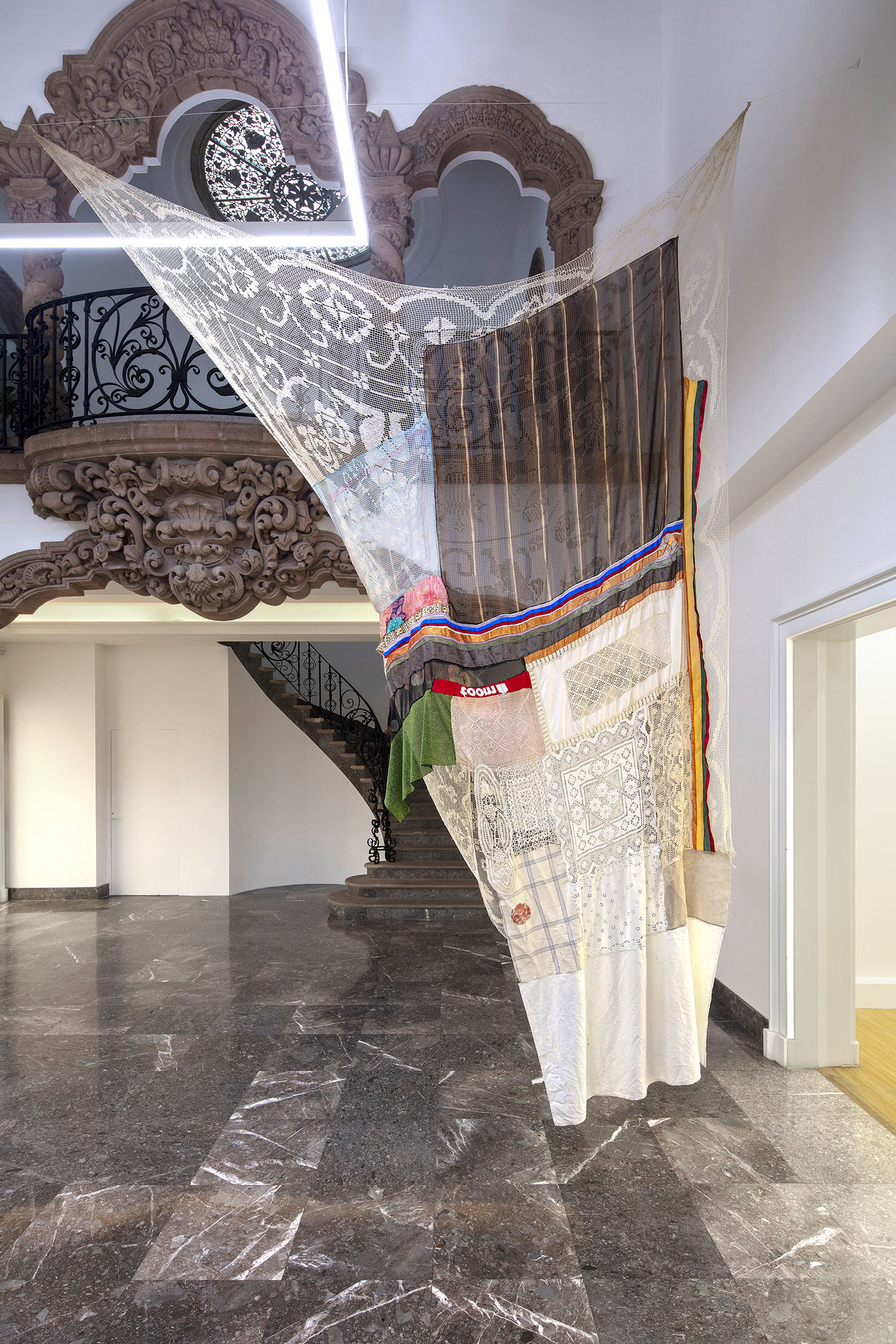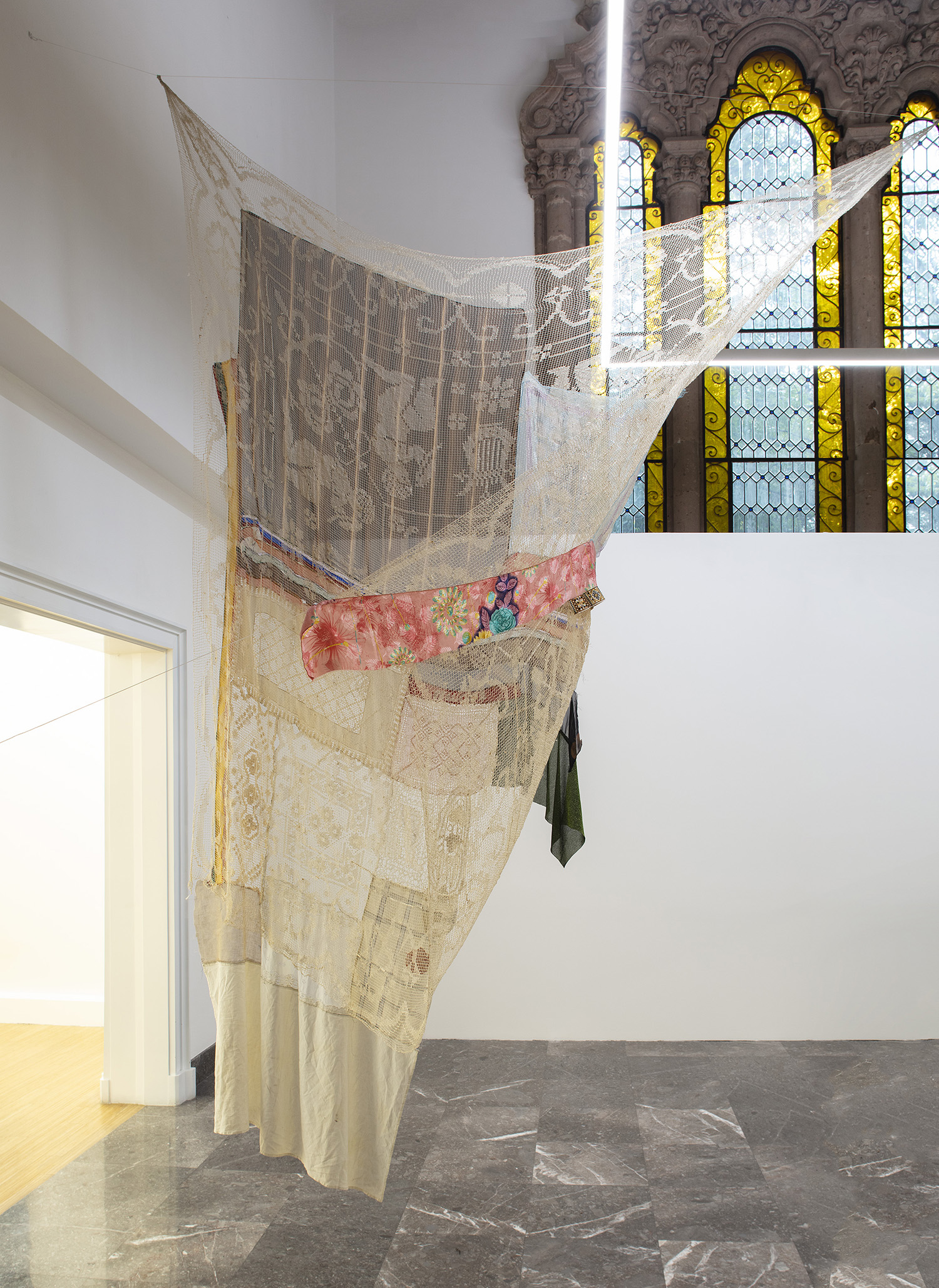
Installation view
Cuts, 2022
Photograph by WhiteBalanceMX
Eric N. Mack Cuts
Morán Morán is pleased to announce Eric N. Mack’s third solo exhibition with the gallery and his first in Mexico City. This show, titled Cuts, presents a new body of work that reinvigorates the perceptions he so adeptly challenges regarding two and three dimensional work, as well as what constitutes a painting or a sculpture. For the exhibition, Mack created a half-dozen pieces at various scales, some that instigate the canvas versus stretcher relationship and others that relate to the structure of architecture. Cuts turns a few corners on his well-established practice, which continues to deliver visually and texturally provocative objects that also speak to formal aesthetics of color and form.
Some of Mack’s paintings release from their supports to break off the picture plane, reaching out from the wall to spill onto the floor and cascade across the room. But here, with a series of stretched works, he provides a prequel to that material life so that the canvas remains on its stretcher but portions of the stretcher itself are visible. With one of the largest works in the show, which measures just over 10 feet tall, a rigid aluminum stretcher peeks out in a few areas, reflecting in the light, revealing its function, and contradicting the flexible skin of the composition it supports. On the surface, a beautifully intricate weave of fabrics, securely stitched together, combine into a spectral quilt that pulls taught to edges with orchestrated moments of swells and ruptures.
Stripes, florals, grids, and abstract shapes coalesce with a full palette of colors and materials that range from polyester to silk, in all stages of life from pristine to tattered. At times Mack’s compositions lean symmetrical and at a distance they could pass for aerial abstractions of a built environment, but the insistence is that of a gridded space – the geometry and repetition of a non-objective realm. However, through his selected media any non-figurative notion is disrupted by the inference of the body, of shelter, and of home.
Whereas the stretched works articulate a compression of installation, the loose and sweeping scaffoldless fabric works hint that some paintings have broken free. Patterned, plain, torn, and resewn, these soft assemblage pieces are composed of materials with a lifespan, which also carry a sense of place. One work, suspended in the gallery’s center space, unites various textiles; the most prominent section of the piece is an Italian filet lace tablecloth, replete with dancing putti, satyrs, and harps. The intricate design of this lace is executed with open needlework which appears more sheer because it hangs perpendicular to the floor. Reading like an oversized veil, the other side of this Italian heirloom discloses a composite of opaque fabrics – one is vibrantly striped, and one small red piece has white printed text that spells toom, or inverted: moot.
Throughout Mack’s show we find interjections of text, from printed logos, to embroidered letters, to tiny words barely legible on fabric tags. This language is given to the textiles and it is formatted within the compositions as concrete poems. With Cuts, Mack provides these subtle indications as he repeats material propositions, so that there is a rhythm to the exhibition and also a harmony contained within each work.
Morán Morán se complace en presentar la tercera exposición individual de Eric N. Mack con la galería y su primera en Ciudad de México. Esta muestra, titulada Cuts, presenta un nuevo cuerpo de trabajo que revitaliza las percepciones que él tan hábilmente desafía en lo que respecta a las nociones tradicionales en torno a obras bidimensionales y tridimensionales, así como lo que constituye una pintura o una escultura. Para la exposición, Mack ha creado media docena de piezas a distintas escalas, algunas de las cuales instigan la relación entre el lienzo y el bastidor y otras se vinculan con la estructura de la arquitectura. Cuts da un giro a su consolidada práctica, que sigue ofreciendo objetos visual y texturalmente provocativos que también hablan de la estética formal del color y la forma.
Los cuadros de Mack se desprenden de sus soportes para romper el plano pictórico, saliendo de la pared para derramarse en el suelo y caer en cascada. Aquí, con una serie de piezas estrechadas, ofrece una precuela de esa vida material, de modo que el lienzo permanece en su bastidor pero partes del propio bastidor se visibilizan. En una de las obras más grandes de la exposición, que mide algo más de tres metros de altura, un bastidor rígido de aluminio asoma en algunas zonas, reflejándose en la luz, revelando su función y contradiciendo la piel flexible de la composición que sostiene. En la superficie, un hermoso e intrincado tejido de telas, cosidas con seguridad, se combinan en una colcha espectral que jala de las orillas con momentos orquestados de oleadas y rupturas.
Rayas, flores, cuadrículas y formas abstractas se combinan con una completa paleta de colores y materiales que van desde el poliéster a la seda, en todas las etapas de vida, desde prístina a andrajosa. A veces, las composiciones de Mack son simétricas y, a distancia, podrían pasar por abstracciones aéreas de un entorno construido, pero la insistencia es la de un espacio cuadriculado: la geometría y la repetición de un ámbito no objetivo. Sin embargo, a través de sus medios seleccionados, cualquier noción no figurativa se ve interrumpida por la inferencia del cuerpo, del refugio y del hogar.
Mientras que las obras tensadas articulan una compresión de la instalación, las obras de tela suelta y sin andamios insinúan que algunas pinturas se han liberado. Estampadas, lisas, rasgadas y vueltas a coser, estas suaves piezas de ensamblaje se componen de materiales con una vida útil, que también conllevan un sentido de lugar. Una obra, suspendida en el espacio central de la galería, une varios tejidos; la sección más destacada de la pieza es un mantel de encaje de filete italiano, repleto de amorcillos danzantes, sátiros y arpas. El complejo diseño de este encaje está ejecutado con una labor de aguja abierta que parece más pura porque cuelga perpendicularmente al suelo. Como si se tratara de un velo de gran tamaño, el otro lado de esta reliquia italiana revela una composición de telas opacas: una de ellas es de rayas vibrantes y una pequeña pieza roja tiene un texto impreso en blanco que deletrea toom, o sea, al revés: moot.
A lo largo de la exposición de Mack encontramos intercalaciones de texto, desde logotipos impresos, hasta letras bordadas, pasando por pequeñas palabras apenas legibles en las etiquetas de las telas. Este lenguaje se da a los textiles y se formatea dentro de las composiciones como poemas concretos. Con Cuts, Mack proporciona estas sutiles indicaciones mientras repite las propuestas materiales, de modo que hay un ritmo en la exposición y también una armonía contenida en cada obra.
Dates
September 21 - October 22, 2022Opening Reception
Wednesday, September 21, 6-8pmLocation
AV. HORACIO 1022, POLANCOMIGUEL HIDALGO 11550
CIUDAD DE MÉXICO
Artist
Eric N. Mack
Installation Views
All images: Cuts, 2022, installation views. Photographs by WhiteBalanceMX

Installation view
Cuts, 2022
Photograph by WhiteBalanceMX

Installation view
Cuts, 2022
Photograph by WhiteBalanceMX

Installation view
Cuts, 2022
Photograph by WhiteBalanceMX

Installation view
Cuts, 2022
Photograph by WhiteBalanceMX

Installation view
Cuts, 2022
Photograph by WhiteBalanceMX

Installation view
Cuts, 2022
Photograph by WhiteBalanceMX

Installation view
Cuts, 2022
Photograph by WhiteBalanceMX

Installation view
Cuts, 2022
Photograph by WhiteBalanceMX

Installation view
Cuts, 2022
Photograph by WhiteBalanceMX
Artworks

Eric N. Mack
There is No Other Way, 2022
Silk and wool scarves, cotton apron, Irish linen, rope, ribbon, polyester, felt, cotton shirt, and wool
128 x 88 inches
(325.1 x 223.5 cm)
Photograph by WhiteBalanceMX

Eric N. Mack
Cut the Cameras, 2022
Muslin, wool, polyester, silk, moving blanket, index cards, denim, wool scarf, pins, printed photograph, and ribbon
140.5 x 70 inches
(356.9 x 177.8 cm)
Photograph by WhiteBalanceMX

Eric N. Mack
Bootleg Feel, No Fear, 2022
Polyester scarves, cotton, linen, spandex, cotton handkerchief, and feathers
74 x 38 inches
(188 x 96.5 cm)
Photograph by WhiteBalanceMX

Eric N. Mack
See, The Sarcophagus is Moot, Too, 2022
Silk, wool, cotton, polyester, ribbon, thread, microfiber, velvet, handkerchief, and denim
116.5 x 48 inches
(295.9 x 121.9 cm)
Photograph by WhiteBalanceMX

Eric N. Mack
Magic in a Mortal Minute, 2022
Denim, wool, ribbon, microfiber blanket, polyester blanket, velvet, cotton, polyester and silk scarves, Missoni knit, and thread
42 x 27 inches
(106.7 x 68.6 cm)
Photograph by WhiteBalanceMX

Eric N. Mack
Proto-pleats, 2022
Silk scarves, cotton dish towel, Italian lace, satin, linen, ribbon, and thread
112 x 96 inches
(284.5 x 243.8 cm)
Photograph by WhiteBalanceMX

Eric N. Mack
Put it on, 2022
Polyester, kimono silk, rope, boning, and thread
86 x 85 inches
(218.4 x 215.9 cm)
Photograph by WhiteBalanceMX

Eric N. Mack
Siouxsie Sphynx, 2022
Cotton lace, linen handkerchief, vintage lace, polyester, cotton, ribbon, silk scarves, and rope
137 x 62 x 98 inches
(348 x 157.5 x 248.9 cm)
Photograph by WhiteBalanceMX

